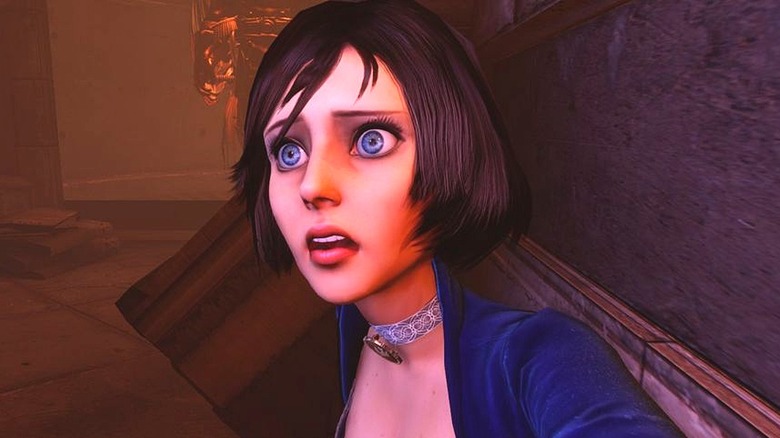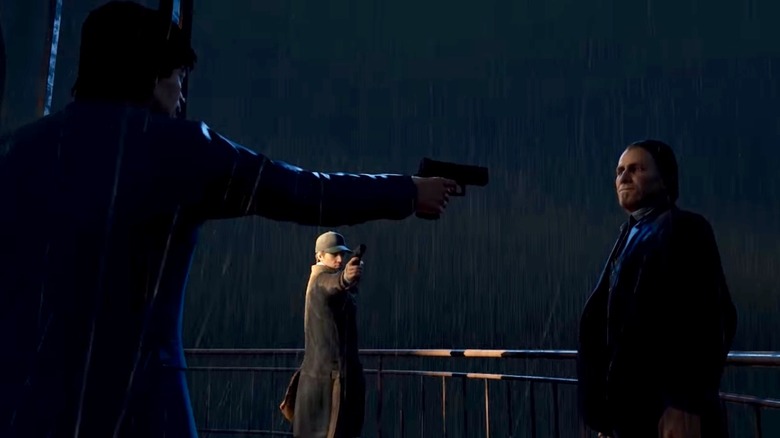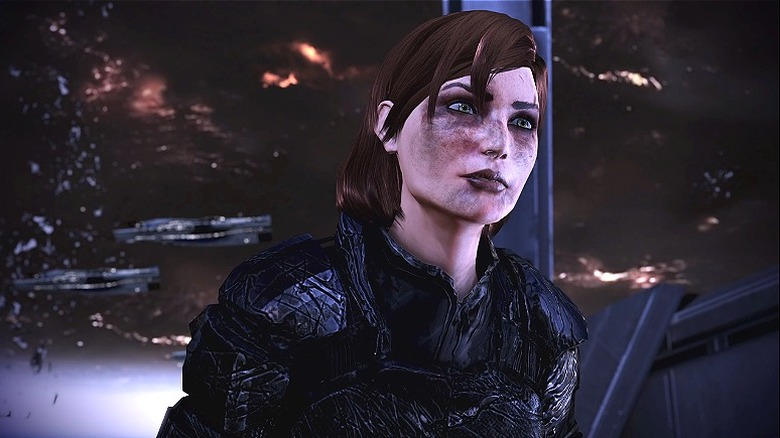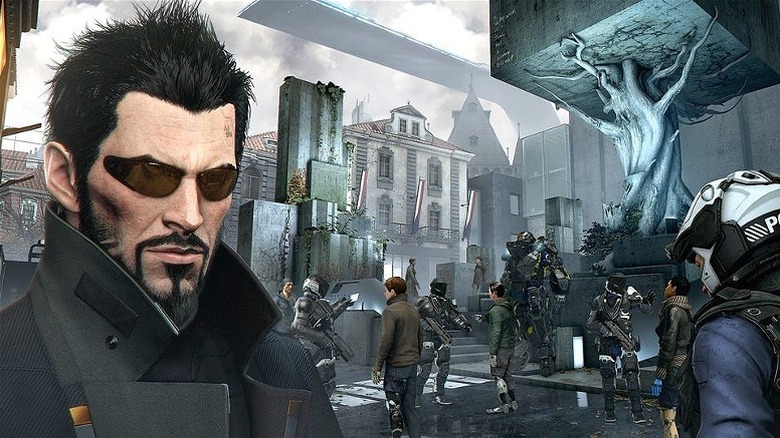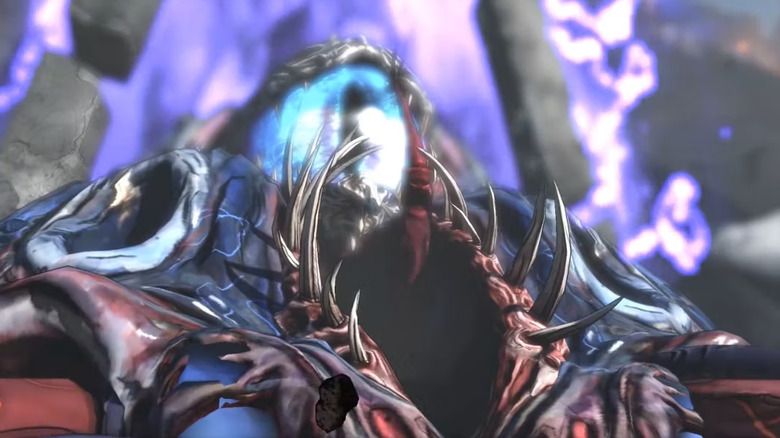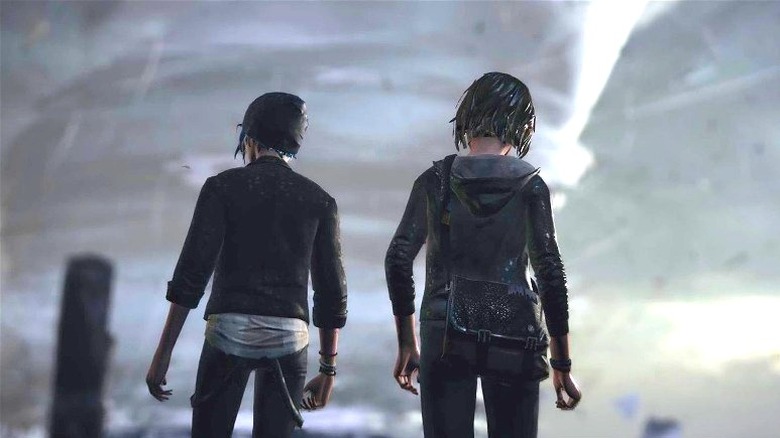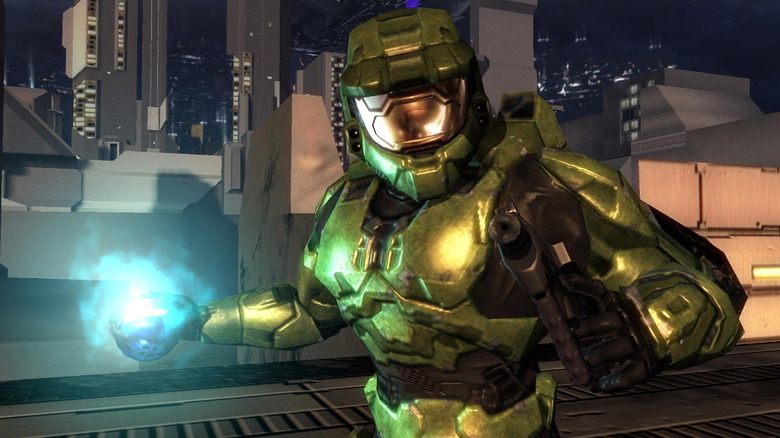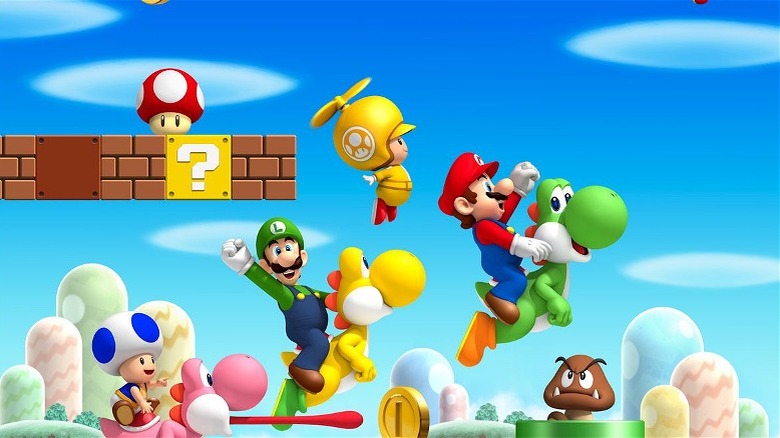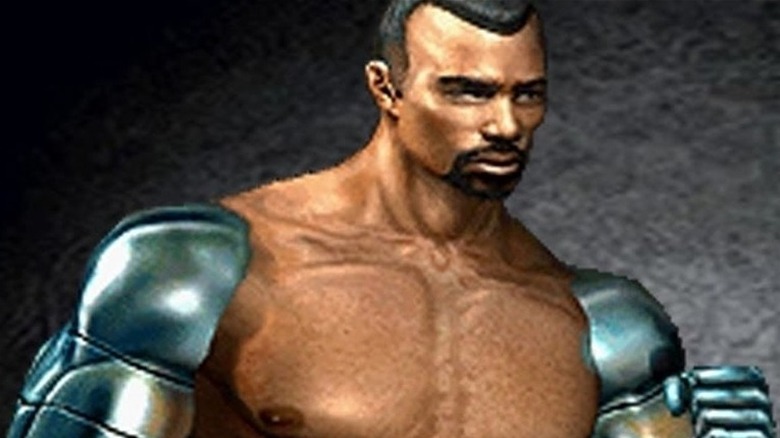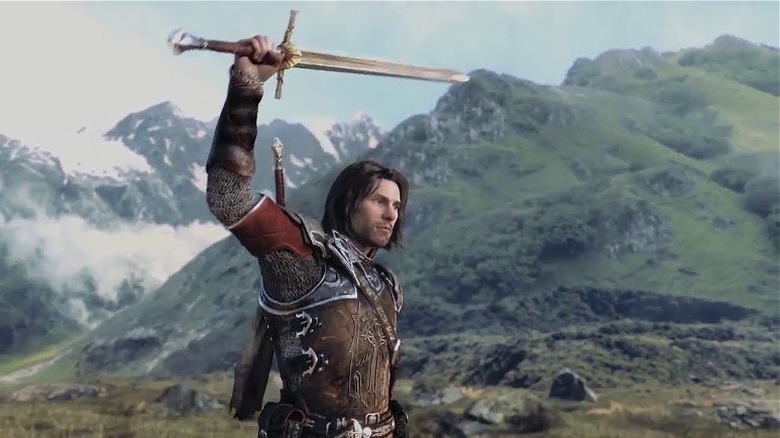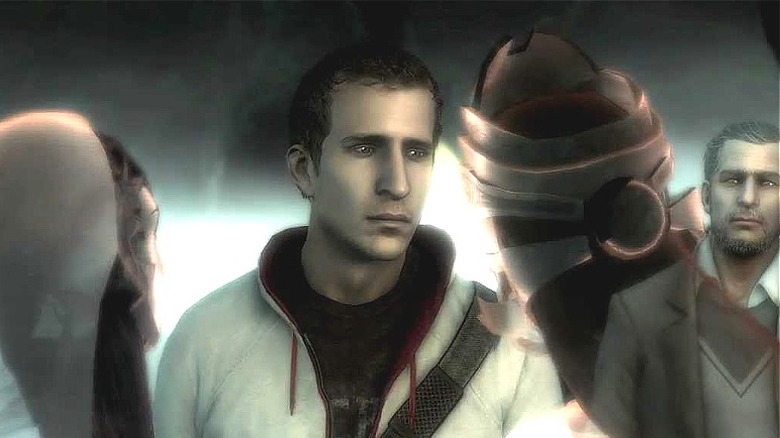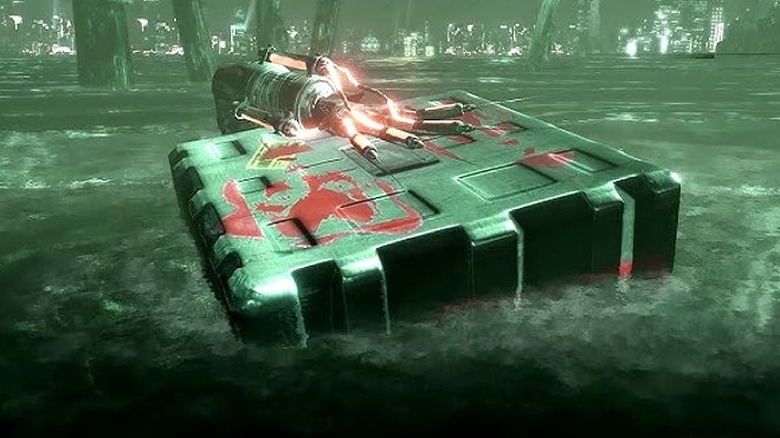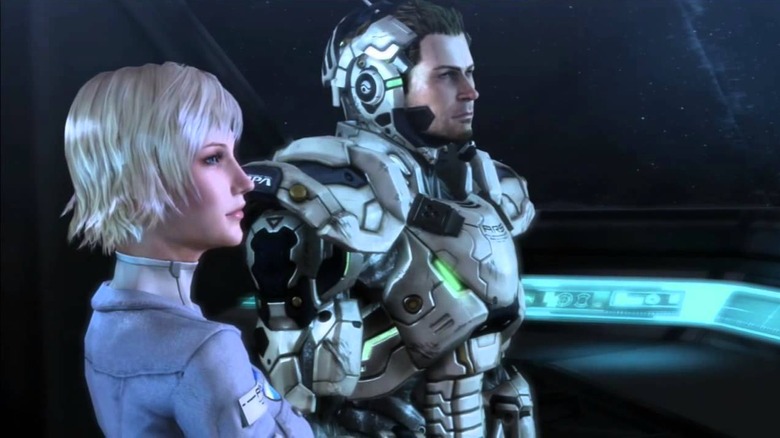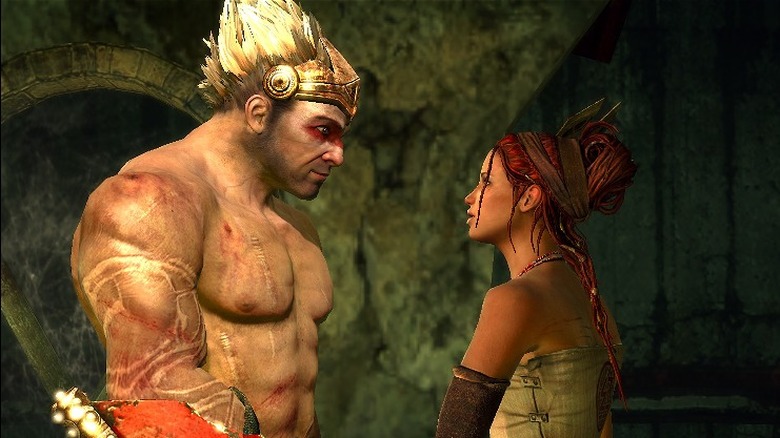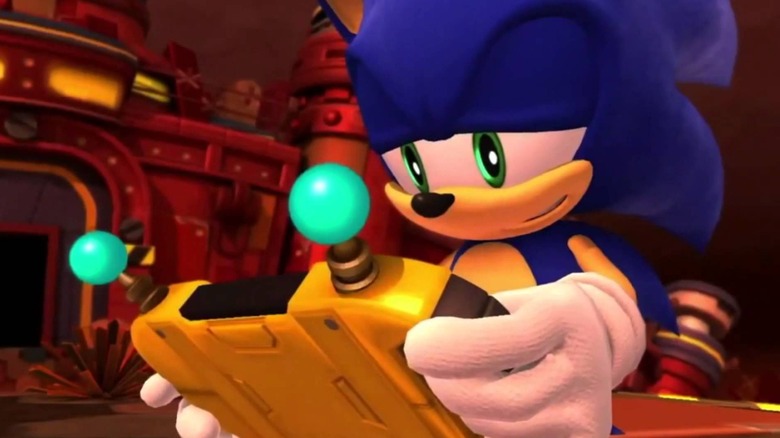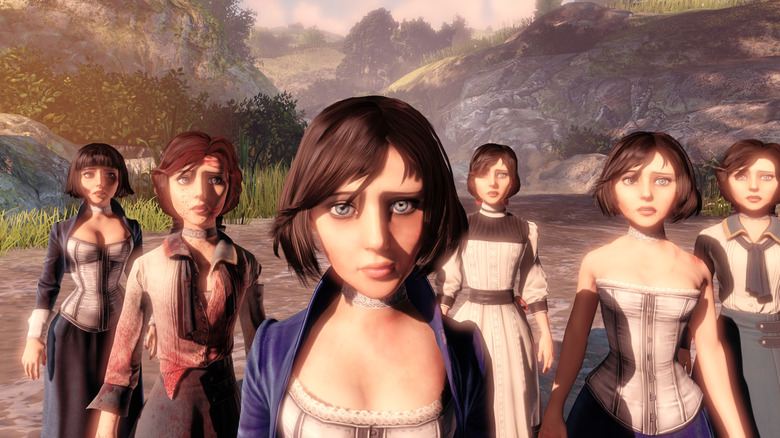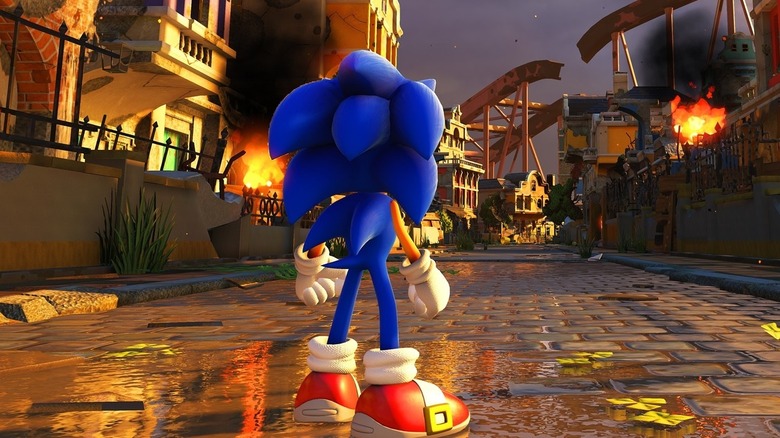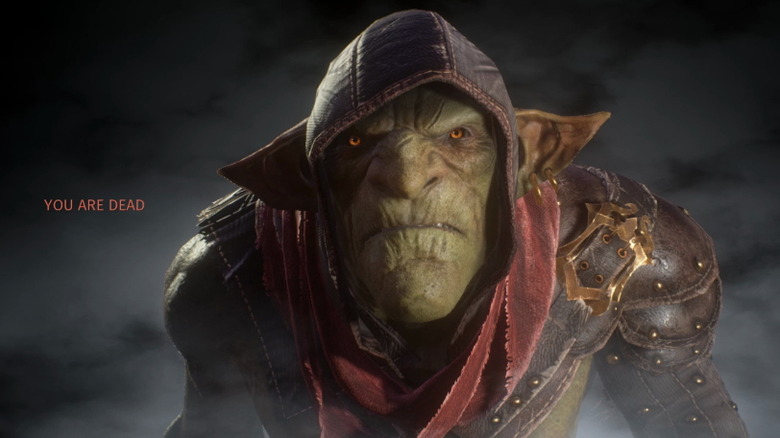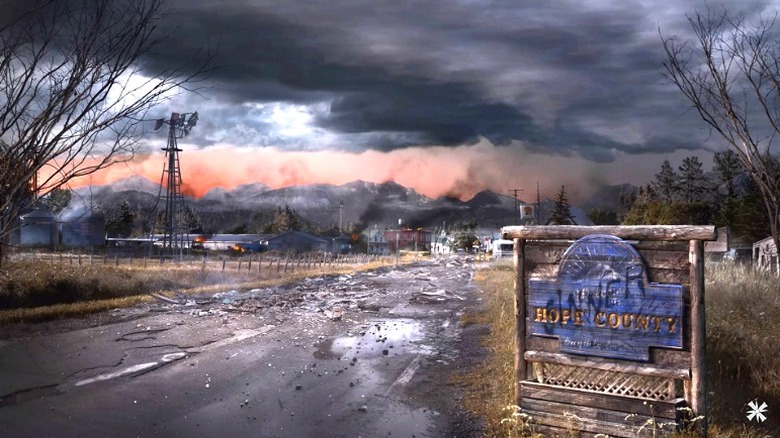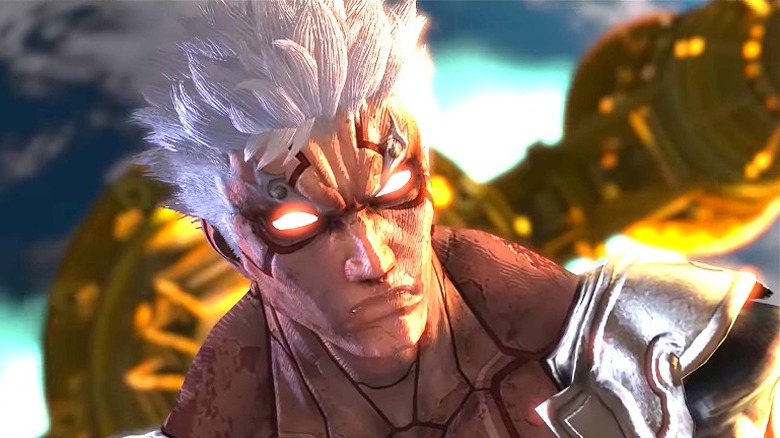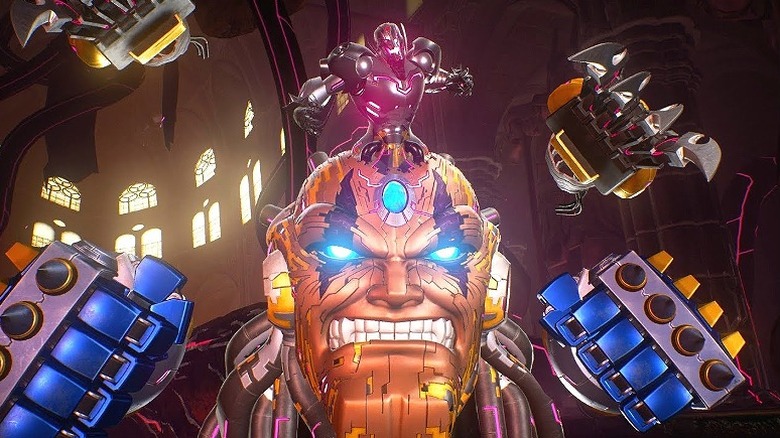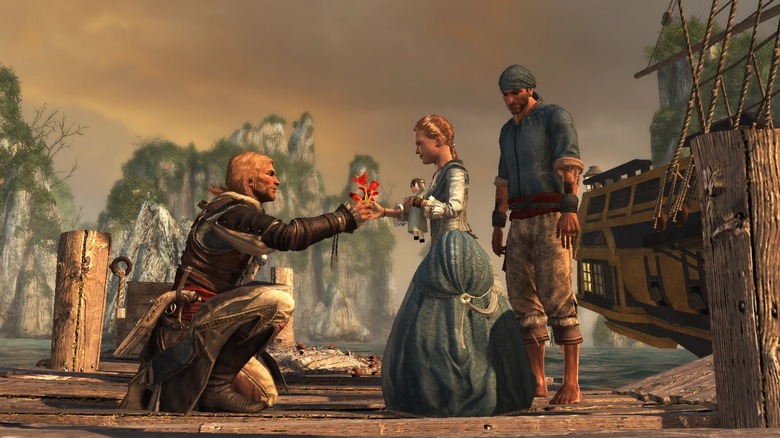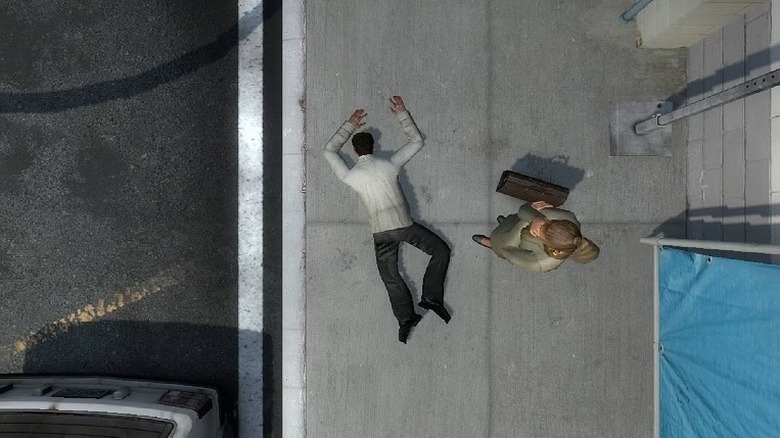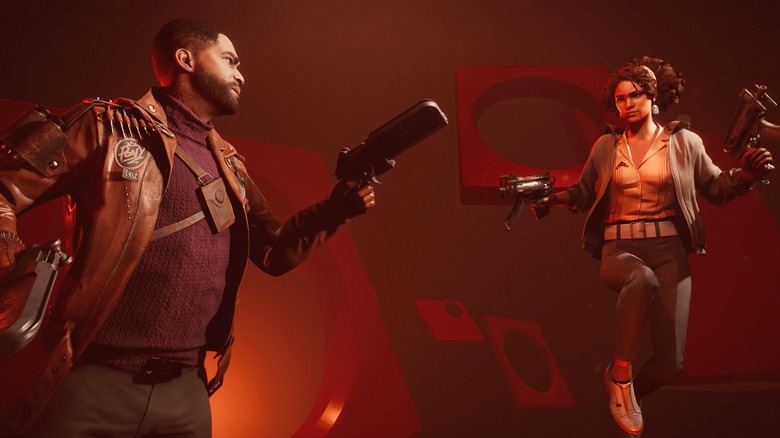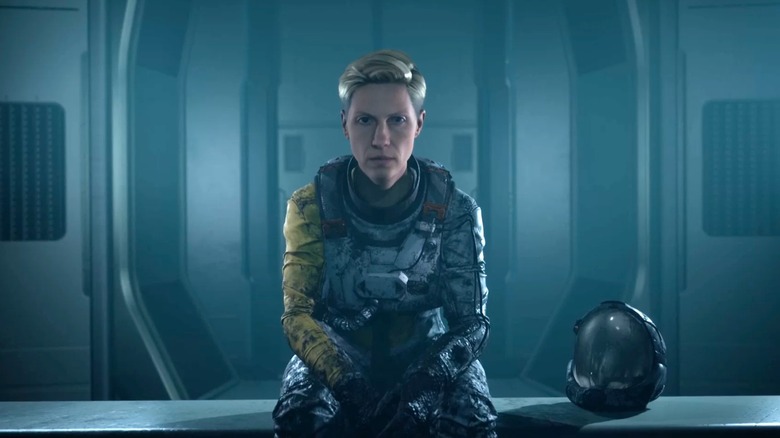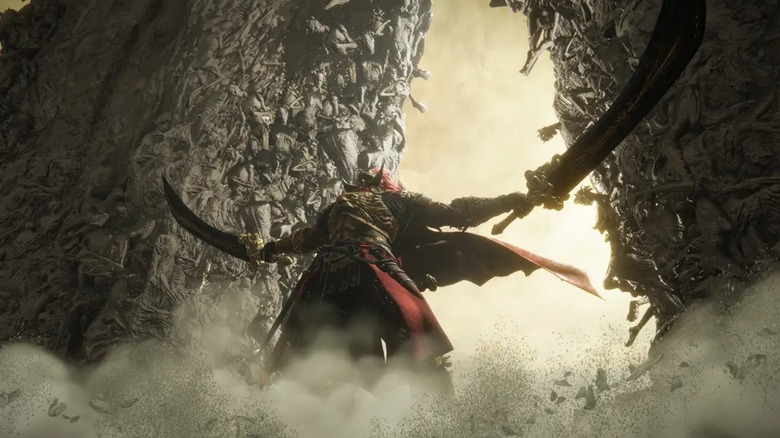The Worst Video Game Endings Ever
There's nothing worse than slogging through a game — especially if it's a massive, 50+ hour affair — just to arrive at an ending that disappoints in every way. And yet, it happens more often than you'd think. Whether the disappointment springs from time travel finales gone wrong or half-baked conclusions so lackluster that they'd make a Saturday morning cartoon blush, all manner of bad endings are present on this list.
Only one theme unifies the following video game conclusions: they're deeply unsatsifying. And it should go without saying, but here it is anyway: massive spoilers ahead for the following games.
Watch Dogs
After spending an insulting amount of time inching towards a resolution for Aiden Pearce's story of revenge on the people who killed his niece, you'd think the payoff would be colossal. The implosion of Chicago? The downfall of the city's entire government? After all, the conspiratorial twist "Watch Dogs" keeps hinting at seems humongous.
Turns out it was all red herrings and bad writing. You take out the game's main villain by hacking his pacemaker and then staring at him through a window — yeah, it's as unexciting as it sounds. You then go after an entirely different group of bad guys. You get rid of the first one in an uneventful lighthouse showdown, and the next inside a garage at the story's epilogue. It's literally yawn-inducing. And the whole time you're slogging through this drab finale — not to mention sitting through all of the game's credits — you're constantly reminded that none of it even matters, because Pearce doesn't see an inch of character development throughout the entire dozen-plus-hour journey.
Mass Effect 3
The infamous starchild is not what fans of the "Mass Effect" series deserved as the finale to their three games' worth of character building. After a trilogy of games loaded with dozens upon dozens of hours of content, each and every "Mass Effect" player had their own unique Shepard, sculpted and molded by their personal decisions and viewpoints. Up until the third game's finale, all of those personal choices had consequences — the likes of which can be evidenced by outstanding levels like the reckless climactic mission in "Mass Effect 2," the outcome of which was determined by what kind of choices you'd made earlier in the games. These sorts of events made the journey through this franchise's universe feel alive and real.
Then came the ending of "Mass Effect 3," which wrapped up Shepard's massive, game-spanning fight against the Reapers with a trip to the world's most high-tech child daycare center. At this place, you negotiate outcomes with a little boy, called the "Catalyst" (but colloquially dubbed the "starchild"), who offers you your pick of three predetermined, color-coded ending cutscenes. That's right: thousands of decisions, dozens of hours of gameplay, and the nonlinear experience of a lifetime culminated in your choice of a "red," "blue," or "green" ending. BioWare eventually released a DLC that extended each ending to have a bit more content (in response to fan uproar), but it still didn't fix the damage that these soulless, hollow finale choices had on an otherwise engrossing series.
Deus Ex: Mankind Divided
Imagine you're watching "The Empire Strikes Back," but instead of getting the full movie, you're only allowed to view the film up until the end of the battle of Hoth, also known as the end of act one. Well, that's what you get with "Deus Ex: Mankind Divided." The final showdown is essentially the end of the first act's narrative, leaving the door wide open for the real conflict to begin. Unfortunately, that's also where Square Enix turns off the valve and rolls the credits. In that sense, it's one of video gaming's worst endings–because it isn't one. "Mankind Divided "has no resolution, only a heavy-handed cliffhanger designed to force players to buy the next installment if they want closure with the narrative. If you didn't know better, you might see it as an attempt to artificially manufacture a trilogy.
Coincidentally, for a series all about conspiracy theories, it seems there's actually a plausible one regarding the aforementioned hypothesis: Some sources claim Square Enix did cut the game in half, creating a deliberately broken narrative. If this rumor is true, the game's story would've been twice as long and had a real ending; fittingly, Square Enix's decision to try to double-dip ended up costing the company, as few bought "Mankind Divided" due to its mixed reception (a major point of contention being its unfinished narrative) which led to the indefinite pause of the would-be finale's development.
Borderlands
In "Borderlands," you spend the entire game working towards opening The Vault, a chamber filled with untold riches and secrets. To open said Vault, you need a key — one you eventually acquire, prompting an epic finale where you fight your way to The Vault's entrance, kill a giant monster ... and don't open The Vault. Roll credits.
As it turns out, the key isn't actually a key, and supposedly no one can open The Vault. So the ending consists of you finding this out, handing off the key to a scientist, and then going about your way, back to whatever boring merc adventures you were doing previously. It's a non-ending. This is the kind of twist that's usually reserved for the halfway point of a story, wherein the protagonists realize the real objective was hidden in plain sight, or something of that nature. Good stories never just end at "and then, the main characters realized the whole adventure was pointless, and went home." And it's not like this ending was tacked onto some little indie game that only took a few hours to burn through, mind you. This was the disappointing conclusion to a massive, open-world grindfest of a game that likely took an hour-count in the double digits to complete. To this day, it remains one of gaming's most insulting bait-and-switch finales.
Life Is Strange
"Life Is Strange" has one of the most egregiously frustrating endings in gaming history — in fact, there's two of them. No matter which one you pick, you lose. None of the decisions you make actually feel like they matter at the end of this Square Enix title. At most, you'll get to make one pivotal decision towards the game's climax and that's it.
"Life Is Strange" gives you two options: save your best friend in exchange for the life of an entire town with thousands of people, or save the town and retroactively negate literally every event of the game leading up to that point. Basically, it boils down to "do you want to actually have an impact on the narrative and screw over a bunch of people for one hipster, or do you want to do the right and smart thing in exchange for feeling like you didn't even matter to the story?" It's an ugly setup, and one we have to believe the writers chose to go with out of convenience. A real, meaningful ending would've required a level of effort we can only assume they just didn't have at that point.
Halo 2
This may sound controversial, but the ending of "Halo 2" was so bad that even the developers never wanted it. The fact of the matter was that "Halo 2" had some serious deadline issues, and in order to get the game released by the date Bungie had been assigned, certain things needed to be cut — including a level that would've picked up right after Master Chief's infamous cliffhanger line: "Sir, finishing this fight." The ending we got, though, set the stage for an epic finale but cut to black literally moments before it started.
It was as obvious of a sequel setup as one could imagine; an ending only made worse by the fact that we now know even the devs felt ashamed for releasing something so devoid of resolution. While "Halo 3" tied things together nicely and somewhat made up for this transgression, it doesn't change the fact that the preceding game's lack of closure more or less started the bad trend of sequel-bait anti-endings in AAA video games. In this sense, this isn't just a bad ending from a narrative perspective — its negative consequences transcended the game and trickled into the real world. It doesn't get much worse than that.
New Super Mario Bros. Wii
"New Super Mario Bros. Wii" is a colossal pain when it comes to 100-percenting its content. You've got to find every single secret stage exit and hidden path in the hub worlds, complete every single level, find and collect each level's three big star coins, and then triumph over that godforsaken bonus world. You'd imagine Nintendo has a pretty big bonus in store for those willing to slog through this game's nightmarish completist's challenge.
Turns out, there's nothing. No true ending to the game, no cute bonus cutscene, no secret ability or special power-up you get after all that toiling; there's just a "thanks for playing" message that confirms you've finished the game — and leaves you feeling like a complete idiot for having spent all that time working toward a meaningless goal.
Mortal Kombat 4 - Jax's Ending
This is the kind of ending that one can only assume was made deliberately poorly, as some sort of in-joke amongst the development team at Netherrealm. The characters' animations are super stiff, the voice acting is abysmal, and the dialogue is in so-bad-it's-good territory. After seemingly chucking himself off a cliff, Jarek surprises Sonya Blade and throws her to her doom. He joins her quickly thereafter, as Jax shows up spouting a lot of quips for someone who just watched their closest partner die.
Really, this cutscene works best as a blatant mockery of the "Mortal Kombat" series. Jax doesn't sound intimidating; he sounds like a guy with a stuffy nose that the dev team pulled away from the office watercooler to record some lines. And Jarek? Oh boy. His chuckles are probably the most beautifully awkward noises ever recorded for a cutscene in the entire industry. This ending is a cringe factory that pumps out fresh product nonstop for a total duration of one minute and eleven seconds, and it's glorious.
Middle-Earth: Shadow of War
"Middle-Earth: Shadow of War" completely goofed up its ending, but not because it was bad — far from it. The ending itself was great; the issue was that it was locked behind a penultimate fake-out "ending" and several hours of grinding. The first ending, achieved by naturally progressing through the game's story, featured a disappointing quick-time-event-loaded showdown with Sauron. Had that been the game's true finale, this would be an even more egregious entry on the list. However, the fact that the game's true (better) ending was locked off behind hours of busywork makes matters almost as bad. Just like you'd been doing all game, you had to conquer endless generic fortresses and claim dominion over the orcs of Mordor, only this time, there was no plot to spice things up.Just constant grinding until you finally had enough war assets to unlock the final cutscene.
It's a neat Easter egg cutscene that really subverts the average video game narrative (spoiler: it's a sad ending), but that alone doesn't warrant sacrificing so much time to unlock it. Plus, it's not even like the game's grindy finale incentivized the game's microtransactions — it literally existed just so that every player would have to sink a lot of time into the game, to the point where playing became a chore.
Assassin's Creed 3
Of the game's two endings — one involving the long-dead Connor and the other involving modern-day Desmond Miles — only one is good. Unfortunately, it's the former, meaning that every awful bit of plot in the present timeline retroactively negates the meaningful struggles of the past. Connor's storyline revolves around figuring out if the Templars are morally wrong and whether the Americans will be any better than the British when it comes to enslaving and belittling minorities. In the end, he realizes that Americans are just another evolution of the British ideology, one where his people will still be an afterthought in the colonists' road to continental conquest. What a nuanced, somber ending, right? And it's delivered with nothing more than a glance at a slave auction and a look of hidden pain crossing the protagonist's face when he realizes all of his fighting has been for naught. It's expert storytelling 101.
Enter: Desmond. Prepare for sci-fi shenanigans to take a dump all over that previous ending. In the present, Desmond is busy dealing with an all-but-extinct alien race to try and stop the implosion of the planet. This serves as the true culmination of Connor's storyline, the thing that he and all of Desmond's other ancestors have been unknowingly working toward the whole time. It feels like two different writing teams handled this game; one tackling Connor's bold, moving narrative, and the other doing a poor job of ripping off the finale of "Mass Effect 3."
Batman: Arkham Asylum
While this isn't an ending so awful that it retroactively ruins the game, it definitely feels like the sort of thing Rocksteady came up with as a result of having ran out of better ideas. "Let's turn the Joker into a giant, steroid-infused jock monster" was (and still is) not a good twist to throw at Batman fans.
The character of the Joker is all about mind games and using trickery to put heroes in un-winnable situations. However, Joker's endgame move in "Arkham Asylum" was to transform himself into the one thing Batman is guaranteed to beat: a big, dumb goon. It makes no sense, considering Joker had all the advantages: he had Commissioner Gordon as a hostage, a successful plan to steal the entirety of Gotham's media coverage for himself, control over the Arkham Asylum itself, you name it. And then, he threw away all of that victory ammo in favor of 'roiding up and losing to Batman in an old-fashioned punch out. That doesn't seem like something the greatest, smartest villain in Batman's rogues' gallery would do, wouldn't you agree? While "Arkham City" redeemed Joker, "Asylum" really dropped the ball with its big finale. Don't even get us started on the post-credits scene, which (in some cases) teased plot lines that went nowhere involving a randomly selected villain and the super soldier Titan formula.
Vanquish
Coming from PlatinumGames, the developer behind tons of critically lauded and commercially under-loved games, "Vanquish" was another knockout release that sold poorly and was quietly slated to never receive a sequel. Which is really too bad, because it ends on a massive, terribly irresponsible cliffhanger.
There's minimal resolution to the story, what with the main villain escaping, the hero stranded in space, the United States military in coup d'etat chaos, and a ton of other little threads still dangling after the credits roll. It's agonizing for fans to see an ending like this go unresolved indefinitely, and it's cruel on the developer's part to have left the door so wide open.
Enslaved: Odyssey to the West
This is one of the more noble failures of video game storytelling, as it tries really, really hard to be good. The issue is, well, it uses a twist that a certain other sci-fi story once did — one called "The Matrix." And here's a rule of thumb: Unless your game or movie's name is "The Matrix" and is being released in 1999, don't include any of its plot devices. It just never works.
Barring a cool and surprising appearance from Andy Serkis himself, who also voices and motion captures the protagonist of the game, there's just not a lot of good stuff to say about this ending. It seems like a bit of a "well, how do we explain everything" kind of conclusion that the writers conjured up to justify the wild journey. Though it has the right sense of importance and scale, it really lacks in the payoff category, as no one really does anything besides potentially doom an entire shelter of humans to starvation and savagery when one of the protagonists destroys the shelter's virtual-reality life support systems.
While this frees the minds of everyone inside, it only means they now get to freely traipse about a world as sad and barren as the one seen in "Mad Max." That really doesn't seem like that much of an upgrade from the happy VR world they were "trapped" in previously. That, and an overall lack of character growth or impact, hamper this "Matrix"-lite finale.
Sonic Lost World
In a game where the villains make genocidal remarks and threaten to send Sonic home in a body bag, the ending of "Sonic Lost World" is a brief two-minute cutscene that sees the hero literally pressing a button and making everyone happy again. Seriously.
It's like the ending of a bad Saturday morning cartoon, and undermines a narrative stuffed with interesting twists and shocks. You beat the final boss and then a cutscene takes over, wherein Sonic immediately sees the magic button sitting right out in the open, the one that'll make everyone happy again by restoring color and vibrancy to the world. Then Tails swoops in, says some stuff about the power of friendship, and BAM! Everything is fixed. There was no meaning to the story, no payoff to be found. And it's all because of that awful, overly short, childish, and underwhelming ending.
BioShock Infinite
This one's just a mess. On one hand, any game with a story revolving around time travel is just asking for trouble, but "BioShock Infinite" deals with this narrative death knell in an especially obnoxious and pretentious way. Basically, at the end of the game you kill a radical preacher, who — wait for it — turns out to be you from a different timeline. That's right, you basically kill your future self in order to stop yourself. It's then followed up by an awkward sequence in which your companion, Elizabeth, drowns your character in order to kill any possible alternate dimension eventualities occurring again.
Not only is that a terribly immature way to deal with the concept of possibilities and potential, but it's also silly. It opens up so many logic gaps that trying to address them all would take up enough space to be its own feature.
Sonic Forces
The ending of "Sonic Forces" reeks of being the byproduct of a game that was rushed to release. Everything about it feels sloppy and unfinished: The finale's cutscenes are lazily animated and overly brief (some scenes even have weird animation errors, such as this one where Shadow and Rouge smile as the sun itself is about to burn them to death), the "climactic" levels feel like they belong in the middle of the game due to their easiness, and the story's resolution wraps up in such a way that you can tell the writers either didn't care or didn't have the time to.
There were two major questions lingering over the plot, up until the finale: How will Sonic and Co. stop Infinite and Eggman, and how will Classic Sonic get home? Neither question receives a definitive answer. The two villains simply disappear after you beat them in some quick fights, leaving the audience with no clue if they're dead, bruised and beaten, or if they somehow escaped. Then, Classic Sonic simply fades back into his own timeline, something which is never explained beyond "the plot requires him to go home." Neither of these beats make a lick of sense, and when coupled with the underwhelming execution of the cutscenes and zero-stakes nature of the gameplay, this shoddy ending acts as proof that we were not recipients of the epic game we were promised.
Styx: Shards of Darkness
Throughout the entirety of "Styx: Shards of Darkness," there's one major plot conflict: the question of which master conman will triumph over the other, Styx or Djarak. Then, a bit past the halfway point, a twist forces the two foes to team up, wherein they form a begrudging friendship that starts to make you believe they might actually be willing to let bygones be bygones. However, at the very end of the game, twist number two appears and it's revealed that Djarak is still a jerk, so he betrays Styx. This prompts the final cutscene, wherein Styx finally catches up with Djarak and points his crossbow at him, saying the elf won't get another chance to double cross him. The implication, then, is that Styx fires an arrow and kills Djarak.
Of course, that's all it is — an implication. We can't know for sure, as the game tactically cuts to black just as Styx issues his death warrant for his foe-turned-friend-turned-foe, smashing to credits before the final resolution can be achieved. There's no DLC ending, no sequel to continue the story, nothing. Fans of Styx's adventures will just have to come up with their own head canon ending, since the developers couldn't be bothered to resolve the plot officially.
Far Cry 5
"Far Cry 5" has three endings, two of which are pretty lame, plus a third that only takes 10 minutes to unlock. This means you either slog through a dozen-plus hours of gameplay to reach a pair of unsatisfying conclusions or wrap your AAA gaming experience inside the time it takes to go to the bathroom. The two endings that come at the end of the full game both consist of you, the player, losing. In the "good" ending where you take down the bad guy, he actually ends up being right about the impending apocalypse and ultimately takes you down. In the "bad" ending, you realize you can't beat the bad guy on his home turf, so you and your compatriots voluntarily leave town ... only for a last-second "Thriller"-esque twist where it's revealed you've been infected with the bad guy's hypnotic magic.
In the short ending, you also voluntarily leave at the beginning of the campaign ... but, unlike in the long version, you don't end up infected. So, basically, we're left to assume that your character leaves town and calls in the military or some other more qualified organization to take down the game's domestic terrorist antagonist. It's easily the best ending, as well as the most logical. This explains why it comes so soon, but still, it kind of sours the rest of "Far Cry 5," knowing that by actually playing the game you're actively working towards a worse outcome.
Asura's Wrath
At the end of "Asura's Wrath," Asura's comrade asks him whether he has exhausted said wrath. To this, he responds "I don't know." At the time of release, this closing quote was left open to player interpretation. Was it a sobering final remark by a truly lost, hopeless character? Was it an ambiguous tease at a potential sequel? Was it a sign the writers had just run out of ideas?
Evidently, it was none of those. Turns out Capcom's upper management stuck the actual ending in a DLC expansion. For $6.99, players could find the answers to pressing questions like who the actual final boss was supposed to be (God), and whether Asura ever found a way to quell his wrath (yes). While the narrative aspect resolved decently when all was said and done, nothing's worse than an ending you have to pay extra to unlock.
Marvel vs Capcom: Infinite
It's a rare day when a game comes along that feels like it's missing multiple endings. Such is the case with "Marvel vs Capcom: Infinite," a game that should have dozens of conclusions, but actually only has one. Honestly, it shouldn't come as much of a surprise that a sequel with a downgraded roster and minimal single-player and multiplayer content would also see fit to cut out any story from its arcade mode. Still, that branching narrative content is a staple of arcade modes in fighting games.
Not only is the ending of the main story mode a sequel-baiting fake-out (since a sequel isn't going to happen), but most other fighting games have dedicated character stories and individual arcade mode endings (see the "Street Fighter" and "Mortal Kombat" series for examples). We wanted solo endings for Iron Man, Ultron, Mega Man X, Chris Redfield, and the rest of the crew; they deserved their own bookends and story resolutions. These characters are so rich and loaded with mythos that they all deserved better than a singular bland and unresolved ensemble ending.
Assassin's Creed 4: Black Flag
As has become increasingly common with the "Assassin's Creed" series, both halves of the story in "Assassin's Creed 4: Black Flag" received disappointing conclusions. Sure, plenty of people just played the game for its swashbuckling pirate-assassin gameplay. For those who did care about the story, though, there were seeds of promise early on across both portions of the narrative. The modern-day segments integrated characters from previous games and the historical story featured a main character who, by all accounts, was not hero or assassin material at all. For this reason, the game's opening act was an interesting time, threading into familiar "AC" continuities while also introducing us to a protagonist poised to redefine how we viewed assassins.
Unfortunately, the game dropped the ball from there on out. The modern-day intrigue disappeared by the end, devolving into a weird hodgepodge of deep "AC" lore mixed with a narrative trajectory that landed players exactly where they started — as a regular, uninteresting employee of Abstergo. The assassin storyline didn't fare much better, resolving itself by having Edward Kenway go from debonair pirate to ... debonair pirate with better suits and a family. There were glimmers of hope in the story's second act when he almost became a memorable assassin like Ezio or Connor, but ultimately, he failed to evolve enough to justify his own protagonist status in the story.
The Stanley Parable
"The Stanley Parable" is a special game that isn't content to just have one ending; it's got well over a dozen of them, all varying degrees of preposterous. While some are fun and others are hilarious, there are a few that are downright abysmal. Knowing the indie developer Galactic Cafe, there's not a chance the trash endings weren't entirely deliberate efforts. Still, we can't help but laugh (and cry) at how rough some of this game's finales really are.
Take the "coward" ending, for example. You literally close a single door at the very start of the game and then the experience is over. While the narrator's comments are funny, it's an ending that barely requires a human player. Then there's the "heaven" ending. You end up in a place where you endlessly press colorful buttons. There's no closure, no purpose, nothing. You just press buttons 'til you want to turn off the game. And of course, we can't forget the "divine art" ending. You press two buttons while a baby cries and a dog barks for four hours. FOUR HOURS. Then you receive a weird, one-minute powerpoint featuring a black brick and some inspirational text. These endings are awful, but befitting of the ineffably quirky, self-aware experience that is "The Stanley Parable." Go play it right away, if only so you can say you got the "broom closet" ending.
Deathloop
"Deathloop" is a mind-bending action game with a supremely compelling sci-fi hook, and that might have been the game's downfall. Players take on the role of Colt, a man trapped on a mysterious island where time resets each day. Colt is trying to break this loop by killing the megalomaniacs who control the island, all while a woman named Julianna hunts him down and tries to kill him. Working out the messy tangle of webs connecting Colt to Julianna, the island's masters, and the time loop itself is incredibly compelling at first, but "Deathloop" doesn't have many answers to reward you with.
By the end of the game, Colt has learned that Julianna is his daughter and that the two of them ended up on the island after her mother tragically died. Julianna enjoys her life in the loop, but Colt was driven mad by his grief and has been losing his memories ever since. He learns that he can finally end the loop (somehow) by killing his own daughter, or he can choose to let the loop continue forever. The game has three endings, but none of them actually address many of the big questions that players will definitely have about Colt, Julianna, the true nature of the Anomaly powering the loop, and what the world is like outside the island. The story in "Deathloop" sets up enough hooks for multiple sequels (and tantalizing connections to the "Dishonored" universe), but doesn't provide nearly enough closure for a satisfying ending.
Returnal
2021's "Returnal" is an excellent third-person roguelike that successfully makes the game's mechanics an integral part of the story. Players take control of Selene, an astronaut who crashes onto an alien world and must fight a variety of alien creatures to survive. Every time Selene dies, she finds herself waking back up at the crash site and fighting through a slightly altered version of the planet. The main narrative hook would seem to be the mystery of what exactly is happening to Selene, and that's why some fans walked away from the ending of "Returnal" feeling a little cheated.
The basic ending shows players a flashback in which Selene is driving a car with a child in the back when the two of them are struck by another vehicle and tossed into a river. Selene is seemingly pulled from the car by the bizarre force that resurrected her throughout the game. Fans still debate the ending, but the big reveal appears to be that Selene's experience on the alien world may have all been some kind of dream or a metaphor for a more mundane accident ending her life. A further secret ending layers in some hints about Selene's strained relationship with her mother Theia, as well as suggests Selene's time loop may have also resulted in her time-traveling to cause her own accident, but it's all very vauge. It certainly doesn't add any clarity to the big questions left unanswered by the main ending.
Look, "Returnal" is a masterclass in gameplay and atmosphere. But while the metaphorical ending definitely worked for some players, after spending hours blasting aliens and dying a zillion times, others felt like "Returnal" had pulled a rug out from under them at the last second.
Elden Ring: Shadow of the Erdtree
This may sound like sacrilege, but hear us out. "Elden Ring" players waited two long years for FromSoftware to release the game's DLC, and it mostly didn't disappoint. "Shadow of the Erdtree" is an absolutely massive experience that feels almost more like a full sequel than a DLC. It has some of the best bosses in all of "Elden Ring" and answers some big questions about Queen Marika's most mysterious children, Miquella and Mesmer. As great as "Shadow of the Erdtree" is, though, there's no denying that the ending is a bit of a letdown.
The whole DLC builds to an epic final boss battle at the base of the Gate of Divinity, a supremely creepy giant gateway made of corpses. The boss itself, though, is a rehash of Radahn that left many players feeling underwhelmed and a bit confused. They were hoping that defeating this upgraded Radahn would lead to an epic final cutscene to properly close out "Elden Ring." Instead, the boss battle ends with a brief flashback explaining how Radahn got here — something fans could also learn from item descriptions — and then it lets players go back to the base campaign. There's no way to interact with the Gate of Divinity or to really understand the ramifications of killing Radahn in the first place. The journey may be amazing, but "Shadow of the Erdtree" ends with a whimper, not a bang.

